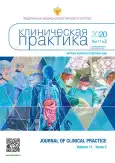Symmetry and gender differences of the knee joint adduction moment
- Authors: Malkov A.B.1, Kondrat’ev S.N.1, Abros'kina M.V.1,2
-
Affiliations:
- The Federal Siberian Research Clinical Centre under the Federal Medical Biological Agency
- Professor V.F. Voyno-Yasenetsky Krasnoyarsk State Medical University
- Issue: Vol 11, No 3 (2020)
- Pages: 43-49
- Section: Original Study Articles
- URL: https://journals.rcsi.science/clinpractice/article/view/17640
- DOI: https://doi.org/10.17816/clinpract17640
- ID: 17640
Cite item
Full Text
Abstract
Background. Gonarthrosis is one of the most insidious degenerative diseases, which has a number of gait biomechanical predictors. Of these, the most studied is the knee joint adduction moment in the support phase, however, there is a lack of research devoted to its reference values among various age and gender groups.
Aim. Evaluation of the gender and functional body asymmetry effect on the peak moments of knee joint adduction in healthy volunteers. Methods. The study was conducted on 38 healthy volunteers (17 men and 21 women) aged 20–45 years using a «Vicon Motion Capture Systems» motion capture hardware-software complex by Vicon (United Kingdom). A comparative assessment was made for the first and second peaks’ amplitude of the knee joint adduction moment in the support phase. The symmetry was evaluated for both peaks in general, as well as separately for men and women. The gender differences for both peaks were evaluated in total for the right and left lower limbs.
Results. The absence of significant intergroup differences in the amplitude of both peaks of the knee joint adduction moment between the right and left legs, irrespectively of gender (p>0.05), was revealed, which demonstrates the symmetry of the adduction forces acting on the knee joint in the support phase. When comparing the amplitudes of both peaks of the knee joint adduction moment in men and women, significant differences were absent for the first peak (p>0.05), but a significantly higher second peak was observed in males (p<0.05).
Conclusion. The obtained variability aspects of the peak moments of knee joint adduction will find their application in the functional diagnostics using the motion capture technology.
Full Text
##article.viewOnOriginalSite##About the authors
Alexey B. Malkov
The Federal Siberian Research Clinical Centre under the Federal Medical Biological Agency
Author for correspondence.
Email: genesis-med@yandex.ru
ORCID iD: 0000-0003-2282-7407
SPIN-code: 4057-2538
к.м.н.
Russian Federation, KrasnoyarskStanislav N. Kondrat’ev
The Federal Siberian Research Clinical Centre under the Federal Medical Biological Agency
Email: stas.84@inbox.ru
MD
Russian Federation, KrasnoyarskMaria V. Abros'kina
The Federal Siberian Research Clinical Centre under the Federal Medical Biological Agency; Professor V.F. Voyno-Yasenetsky Krasnoyarsk State Medical University
Email: mabroskina@yandex.ru
ORCID iD: 0000-0002-1454-1807
SPIN-code: 6011-2040
MD, PhD
Russian Federation, KrasnoyarskReferences
- Багирова Г.Г. Избранные лекции по ревматологии. — М.: Медицина, 2008. — 252 с. [Bagirova GG. Izbrannyye lektsii po revmatologii. Moscow: Medicine; 2008. 252 p. (In Russ.)]
- Коваленко В.Н., Борткевич О.П. Остеоартроз: практическое руководство. 2-е изд., перераб. и доп. — Киев: Морион, 2005. — 592 с. [Kovalenko VN, Bortkevich OP. Osteoartroz: prakticheskoye rukovodstvo. 2nd revised and updated. Kiev: Morion; 2005. 592 p. (In Russ.)]
- Матвеев Р.П., Брагина С.В. Остеоартроз коленного сустава: проблемы и социальная значимость // Экология человека. — 2012. — №9. — С. 53–62. [Matveev RP, Bragina SV. Knee joint osteoarthrosis: problems and social significance. Ekologiya cheloveka. 2012;(9):53–62. (In Russ.)]
- Bout-Tabaku S, Best TM. The adolescent knee and risk for osteoarthritis — an opportunity or responsibility for sport medicine physicians? Curr Sports Med Rep. 2010;9(6):329–331. doi: 10.1249/JSR.0b013e3181fca311.
- Conaghan PG, Sharma L. Fast facts: osteoarthritis. Oxford: Health Press Limited; 2009. 104 p.
- Jalalvand A, Anbarian M, Ahanjan S, et al. Research paper: the effect of knee osteoarthritis on excursions of lower limb joints during gait. Physical Treatments. 2017;6(4):233–241. doi: 10.18869/nrip.ptj.6.4.233.
- Morris R. Knee joint kinematics associated with osteoarthritis in an older cohort. Newcastle upon Tyne (UK): Newcastle University; 2019. 203 p.
- Landry SC, McKean KA, Hubley-Kozey CL, et al. Knee biomechanics of moderate OA patients measured during gait at a self-selected and fast walking speed. J Biomech. 2007;40(8):1754–1761. doi: 10.1016/j.jbiomech.2006.08.010.
- Foroughi N, Smith R, Vanwanseele B. The association of external knee adduction moment with biomechanical variables in osteoarthritis: a systematic review. Knee. 2009;16:303–309. doi: 10.1016/j.knee.2008.12.007.
- Kerrigan DC, Riley PO, Nieto TJ, Della Croce U. Knee joint torques: a comparison between women and men during barefoot walking. Arch Phys Med Rehabil. 2000;81(9):1162–1665. doi: 10.1053/apmr.2000.7172.
- Батршин И.Т., Садовая Т.Н. Разновысокость нижних конечностей с перекосом таза и деформация позвоночника // Хирургия позвоночника. — 2007. — №3. — С. 39–44. [Batrshin IT, Sadovaya TN. Lower limb length discrepancies with pelvic tilt and coronal deformity of the spine. Spine Surgery. 2007;(3):39–44. (In Russ.)] doi: 10.14531/ss2007.3.39-44.
- Seeley MK, Umberger BR, Clasey JL, Shapiro R. The relation between mild leg-length inequality and able-bodied gait asymmetry. J Sports Sci Med. 2010;9(4):572–579.
- Teichtahl AJ, Wluka AE, Morris ME, et al. The associations between the dominant and nondominant peak external knee adductor moments during gait in healthy subjects: evidence for symmetry. Arch Phys Med Rehabil. 2009;90(2):320–324. doi: 10.1016/j.apmr.2008.07.030.
Supplementary files










